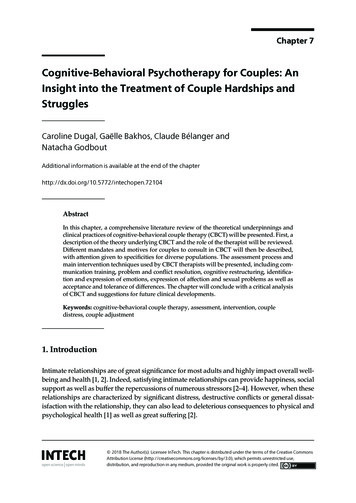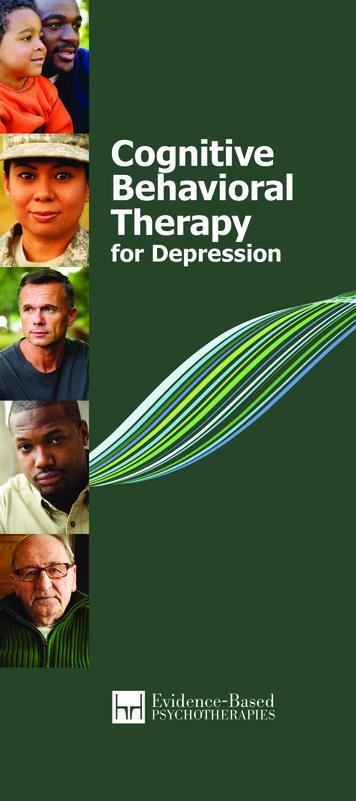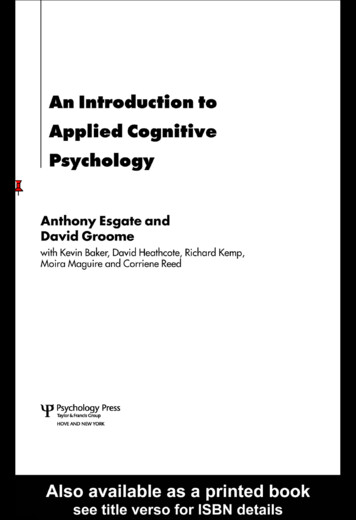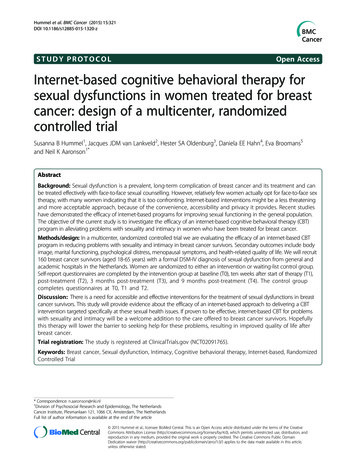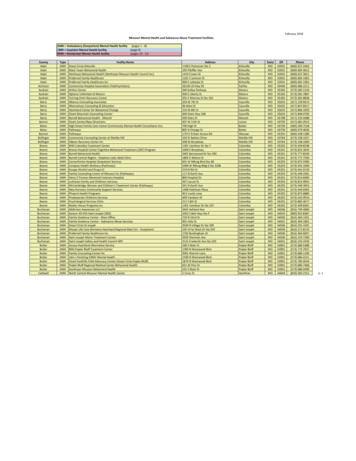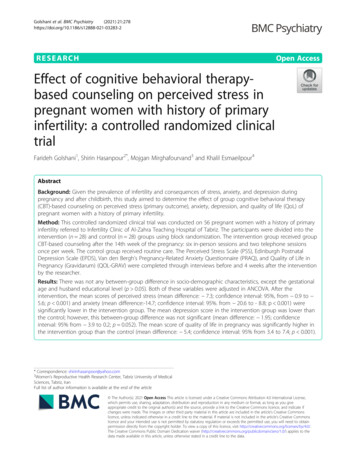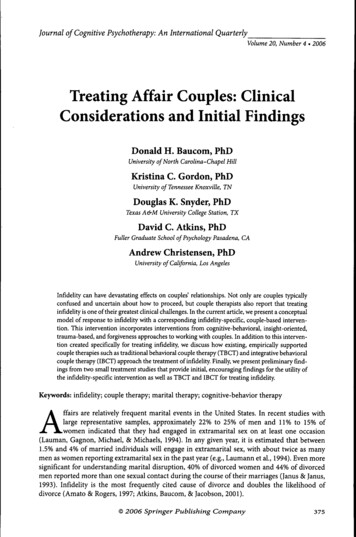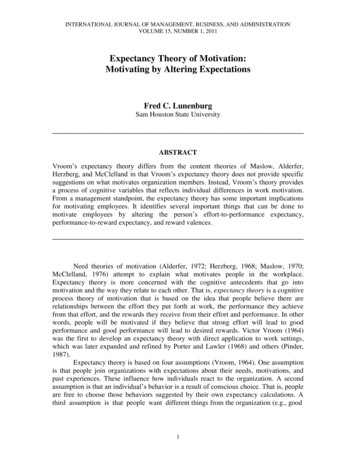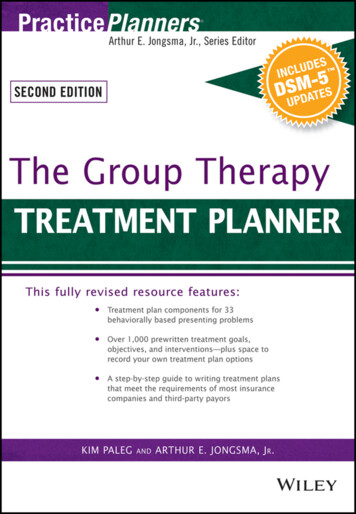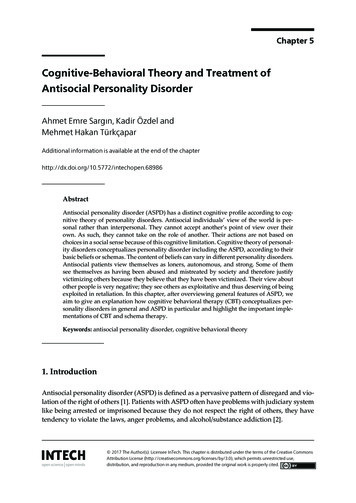
Transcription
DOI: 10.5772/intechopen.68986Provisional chapterChapter 5Cognitive-Behavioral Theory and Treatment avioraland Treatment ofAntisocial Personality DisorderAhmet Emre Sargın, Kadir Özdel andMehmetHakanTürkçaparAhmet EmreSargın,Kadir Özdel andMehmet Hakan TürkçaparAdditional information is available at the end of the chapterAdditional information is available at the end of the bstractAntisocial personality disorder (ASPD) has a distinct cognitive profile according to cognitive theory of personality disorders. Antisocial individuals’ view of the world is personal rather than interpersonal. They cannot accept another’s point of view over theirown. As such, they cannot take on the role of another. Their actions are not based onchoices in a social sense because of this cognitive limitation. Cognitive theory of personality disorders conceptualizes personality disorder including the ASPD, according to theirbasic beliefs or schemas. The content of beliefs can vary in different personality disorders.Antisocial patients view themselves as loners, autonomous, and strong. Some of themsee themselves as having been abused and mistreated by society and therefore justifyvictimizing others because they believe that they have been victimized. Their view aboutother people is very negative; they see others as exploitative and thus deserving of beingexploited in retaliation. In this chapter, after overviewing general features of ASPD, weaim to give an explanation how cognitive behavioral therapy (CBT) conceptualizes personality disorders in general and ASPD in particular and highlight the important implementations of CBT and schema therapy.Keywords: antisocial personality disorder, cognitive behavioral theory1. IntroductionAntisocial personality disorder (ASPD) is defined as a pervasive pattern of disregard and violation of the right of others [1]. Patients with ASPD often have problems with judiciary systemlike being arrested or imprisoned because they do not respect the right of others, they havetendency to violate the laws, anger problems, and alcohol/substance addiction [2]. 2016 The Author(s). Licensee InTech. This chapter is distributed under the terms of the Creative Commons 2017 TheAuthor(s).Licensee InTech. This chapter is distributedwhichunderpermitsthe termsof the ommons.org/licenses/by/3.0),unrestricteduse, mons.org/licenses/by/3.0),whichpermits unrestricted use,andreproductionin anymedium, provided the original work is properlycited.distribution, and reproduction in any medium, provided the original work is properly cited.
100Psychopathy - New Updates on an Old PhenomenonDuring psychiatric interview they may seem inoffensive and even little bit charming but underthis mask of sanity there is aggression, hostility, rage, and tension. They have defensivenesswhen replying the self-report scales [3]. During their lifetime, they repeatedly exhibit traitsof impulsivity, low conscientiousness, which cause social and interpersonal problems. Theymay repeatedly perform illegal acts, lie or malinger people. They are manipulative in order togain personal profit or pleasure. They disregard the feelings or wishes of others. Due to theirimpulsivity, they may change their jobs, accommodation or relationships all of a sudden without taking into consideration of the consequences. They are irresponsible as a partner and as aparent. They frequently have more than one sexual partner and hardly sustain monogamousrelationships. Their children generally live in bad conditions such as lack of hygiene, malnutrition, or accommodation. All these disadvantages result in high rates of unemployment, badhousing, and being imprisoned and dying prematurely due to reckless behavior [4, 5].The two main diagnostic systems, Diagnostic and Statistical Manual of Mental Disorders(DSM-5) and WHO’s International Statistical Classification of Diseases and Related HealthProblems, 10th edition (ICD-10), have similar criteria for antisocial personality construct.According to the latest version of Diagnostic and Statistical Manual of Mental Disorders (DSM-5),ASPD is conceptualized through a criterion set which includes criminal behavior, lying, reckless and impulsive behavior, aggression and irresponsibility [4]. Although it defines a similar construct, the diagnostic label for antisocial personality has different name in ICD-10, asdissocial personality disorder. Dissocial personality disorder is defined in ICD-10 as characterized by disregard for social obligations, and callous unconcern for the feelings of others.There is gross disparity between behavior and the prevailing social norms. Behavior is notreadily modifiable by adverse experience, including punishment. There is a low tolerance forfrustrationand and a low threshold for discharge of aggression, including violence; there is atendency to blame others or to offer plausible rationalizations for the behavior bringing thepatient into conflict with society.The two classifications are not identical but similar. The ICD-10 emphasizes the impairmentin the interpersonal and the affective domain while DSM-5 focuses merely on the antisocialbehaviour. (For instance there is a criteria of low tolerance for frustration, low threshold foraggression and violence in ICD-10 whereas DSM-5 focuses merely impulsivity, disregard forothers, and irresponsible behaviors.) Also conduct disorder before the age of 15 is not necessary in ICD-10 criteria.Antisocial personality like clinical entity is first defined as “moral insanity” in nineteenthcentury by Dr. J.C. Prichard in England. The moral insanity term is later replaced by anotherterm psychopathy [6]. Psychopathy is first defined in “The mask of sanity” book of Cleckleyand later conceptualized by Hare with the psychopathy checklist-revised (PCL-R) [7, 8].Psychopathy is accepted as more severe than ASPD or dissocial personality disorder. It generally includes remorselessness, deceitfulness, egocentricity, superficial charm to others,depression and anxiety, and externalization of blame [9]. The psychopaths generally havelack of fear to aversive events and a deficit in processing affective information regardless ofwhether it is positive or negative [10]. There are studies suggesting that psychopaths havedeficiency in empathy [11].
Cognitive-Behavioral Theory and Treatment of Antisocial Personality The prevalence of ASPD varies from depending on the instruments, methodology, and thecountry. It is between 1.3 and 6.8% for men and 0 and 0.8% for women [5, 12]. The prevalence is higher in populations that are affected by low socioeconomic factors. The ratio ofmen/women is 3. Approximately 50–80% of the criminals meet the diagnostic criteria ofASPD [13, 14]. Patients with ASPD may also have comorbid substance use disorders, anxietydisorders, depressive disorders, somatic symptoms and impulse control problems such asgambling disorder [5, 15, 16].Like most of the psychiatric disorders, antisocial personality disorder is a heterogeneousdiagnosis which has both biological and psychological etiology. From the adoption studies,it is seen that a child who has genetic vulnerability living in an adverse environment is proneto ASPD [17].It was also asserted that psychopaths may have lack of cortical physiological responses thatare associated with experiencing feelings, especially fear. Accordingly, some studies determined that psychopaths do not have autonomic hyperarousal when faced with a provokingstimulus unlike people without ASPD [18, 19].On the other hand, according to cognitive behavioral theory it is assumed that there is developmental delay in the moral maturity and cognitive functioning of antisocial individualswhich we will focus on the next chapter deeply [20].2. Cognitive behavioral theory of antisocial personality disorder2.1. Cognitive behavioral theoryWhen conceptualizing the human behaviour, cognitions and emotions, cognitive model viewsthe cognition under two main titles: Automatic thoughts and schemas. Automatic thoughts arecognitions that accompany the distressful emotions and are specific to that situation/activating event. They are not the product of directed/driven thoughts that are created after a willingprocess. They rather pop up suddenly and the individuals mostly do not notice the automaticthought but the emotion resulting from it. They do not follow grammatical rules but rather theyare set of meanings or images (i.e., “I am a bad mother,” or having an image of himself/herselflying in bed in emergency service) flowing in the mind which are immediately accepted without evaluation by the individual and cause a distressful emotion [21, 22]. So when an activatingevent (A) occurs, this leads to a cognition, interpretation, evaluation, an automatic thoughtwhich is merely maladaptive/functional (B) and this leads to an emotion and a behaviour (C).Accordingly, the cognitive behavioral model emphasizes that it is not the event/situation thatdetermines how the individual feels or behaves (Figure 1). It is the interpretation of that event/situation that determines the feelings and behaviors. This is why cognitive behavioral therapists suggest disputing these maladaptive/dysfunctional thoughts to modify emotions [23].Schemas are divided into two domains: core beliefs and intermediate beliefs (underlyingrules and assumptions). Although some authors like Padesky have used the term schemaonly to describe core beliefs; in general, core beliefs are included as a domain of schema along101
102Psychopathy - New Updates on an Old PhenomenonFigure 1. ABC model of cognitive behavioral therapy.with intermediate beliefs [24]. Core beliefs are the cognitive constructs that determine howto regulate the information about himself/herself and his/her environment and include theessential assumptions about himself/herself, the others, and the world. After being developedas a result of early life experiences/memories and identifications with the important figures,core beliefs are reinforced with the similar experiences and learnings throughout the years[22, 25]. These beliefs about self and life constitute the emotional and behavioral traits of personality. These beliefs are so rigid, fundamental, and deep that even the individual himself/herself does not articulate them. The individual accepts these ideas as undisputable truths.Beck divides the core beliefs in three [25]:(1) Unlovable core beliefs: “I am unlovable,” “I am unattractive,” “I am rejected,” “I am notdesired,” “I am ugly,” etc.(2) Helpless core beliefs: “I am weak,” “I am incompetent,” “I am passive,” “I am a loser,”“I am coward,” etc.(3) Worthless core beliefs: “I am worthless,” “I am bad,” “I am disgusting,” “I deserve to bepunished,” “I am guilty,” etc.Core beliefs exist in pairs in all the humans. For example, an individual has both “I am lovable” and “I am not lovable” core beliefs. A healthy person who does not have a psychiatricdisorder or a personality disorder has the positive core belief as the effective trait (“I amlovable”). When the healthy individual experiences a negative event, the negative core beliefgets activated. For example, when a healthy person breaks up from his/her partner, the corebelief “I am not lovable” gets activated. This person may feel down for a while or he/she mayhave depression for a period. But when he/she gets rid of depression, the positive core beliefbecomes active. If the individual has chronic depression or a personality disorder, this meansthat the positive core belief is very weak. It is generally the negative core belief dominant inhis/her life. As a result he/she is not able to get rid of what that core belief (“I am not lovable”)is imposing. This kind of person only accepts the data confirming the negative core belief anddiscounts the data that does not fit into the schema. The negative core belief is like a broadcasting radio that never stops telling how much unlovable he/she is.Underneath the superficial automatic thoughts, there lie the intermediate beliefs, rules, andassumptions. These rules, beliefs, and assumptions are the abstract regulators of the behaviour although they are not verbalized by the individual. They are settled rules, expectations,
Cognitive-Behavioral Theory and Treatment of Antisocial Personality and attitudes about the individual himself/herself, the others or the world/experiences (i.e.,“If I cry, it means that I am a weak person,” “I must do everything perfect so that peoplewould not understand I am actually incompetent”). Intermediate beliefs are the interconnections between the core beliefs and the automatic thoughts. Their functions are: Maintaining the core belief by bringing an explanation to the life experiences which are incontradiction with the core beliefs. For instance, an individual has a belief of “All humanbeings are bad.” When this person comes across with someone who treats him/her in agood manner, he runs into a contradiction with his/her core belief. In order to overcomethis contradiction, the individual comes up with the intermediate belief “If someone treatsme well that means that he/she has an axe to grind.” Having a life compatible with the core belief: If a person has a core belief of incompetency,he/she avoids taking any risks. Protecting the individual from the intense affect that arises from the activation of the corebelief. For instance, if a person has a core belief of worthlessness, in order not to confrontthis core belief, the individual grabs to the intermediate belief: “If I become successful atwork, I will be worthful.”Intermediate beliefs can be determined by determining the common and repeating themesin the automatic thoughts, by asking the meaning and the possible consequences of the automatic thought (downward arrow technique), or patient filling some scales (i.e., dysfunctionalattitudes scale—DAS) [22].To sum up, cognitive behavioral model assumes that we all have core beliefs that are rootedfrom genetic disposition and early childhood experiences. These core beliefs determine ourintermediate beliefs (assumptions, rules, attitudes). Together these two are called schema.Schemas are kind of reservoir, which has explanations, assumptions, and strategies about theindividual, others, and the world. When an activating event occurs, automatic thoughts aregenerated from this reservoir and shape feelings and behaviors (Figure 2). What cognitiveFigure 2. Cognitive structure.103
104Psychopathy - New Updates on an Old Phenomenonbehavioral therapy does, is to decrease the distressful emotions by disputing the maladaptivedysfunctional automatic thoughts first, and drying the reservoir (schemas) which from whichthese thoughts generate in the long run if the client frequently/chronically gets effected bythese schemas. In cognitive behavioral therapy, cognitive processes can be integrated with thebehavioral strategies to optimize the learning process.Let us consider a person who has antisocial personality disorder and when this person getsacross with new people he/she may have thoughts of cheating or giving harm. These thoughtsmay come from the intermediate beliefs of “I must be the one who hits first, otherwise I willbe the loser,” “Other people are nothing but wimps and they exist in life for being cheated/deceived,” or “Laws are impediments for a satisfactory life and they are for weak people, ifI obey the laws I will be exploited by other people.” Of course these beliefs may be very wellreflection of the core belief “I am weak and I may get hurt.”Today, with many schools focusing on the different components (i.e., schema therapy, dialectical behavioral therapy, acceptance, and commitment therapy, mindfulness based cognitivetherapy) cognitive behavioral therapy (CBT)is found to be effective in numerous psychiatricdisorders/psychological problems like depression, obsessive-compulsive disorder, panic disorder, generalized anxiety disorder, personality disorders, eating disorders, couple problems,family problems, and anger control problems [26–30].2.2. Schema concept according to YoungSimilar to cognitive behavioral therapy, Jeffrey Young stated that schemas develop in childhood in response to genetic predisposition and some environmental influences. Young viewedschema as resulting from unmet emotional needs in childhood [31]. To explain these unhelpful schemas, he introduced the concept of early maladaptive schemas (EMSs). According toYoung, EMSs are unconditional and dysfunctional beliefs about the self. Like the adaptiveschemas, EMSs develop from early experiences with the parents, caretakers, or peers duringthe childhood. A child who is not able to get his/her basic needs actualized; he/she developsschemas as the coping mechanisms to make sense of the experience and the world aroundhim/her [32]. Young has delineated 18 schemas in five domains. These domains reflect thebasic emotional needs of the child. The domains and the early maladaptive schemas are listedbelow [31]:(a) Disconnection and rejection: Abandonment/instability, mistrust/abuse, emotional deprivation, defectiveness/shame, social isolation/alienation(b) Impaired autonomy and performance: Dependence/incompetence, vulnerability to harmor illness, enmeshment/undeveloped self, failure(c) Impaired limits: Entitlement/grandiosity, insufficient self-control/self-discipline(d) Other-directedness: Subjugation, self-sacrifice, approval-seeking/recognition-seeking(e) Overvigilance and inhibition: Negativity/pessimism, emotional inhibition, unrelentingstandards/hypercriticalness, punitiveness
Cognitive-Behavioral Theory and Treatment of Antisocial Personality Because each schema has interpersonal, cognitive, and affective components, and it gives aperspective to the individual about the unmet needs that are experienced during early childhood; when EMSs are activated, high levels of affects show up causing significant distressand even psychiatric disorders. To overcome this distress, the individual may choose threeoptions. Whichever option he/she chooses, he/she may decrease the intense affect, but theschema will be reinforced anyway. According to Young, these three options are [31]:(1) Schema maintenance: Individuals, who have schema maintenance, accept the schemaas completely true. Although they experience the negative emotions provoked by theschema, they keep on behaving in a way to confirm the schema. In their adulthood, theyre-experience the similar traumas which created that schema. This type of behaviour islike taking the same action and hoping for a different outcome desperately.(2) Schema avoidance: In this type of maladaptive coping mechanism, the individualcompletely tries to ignore the schema. They try not to think or feel anything that has a potential to trigger schema. In order to avoid the schema, they may spend their time todistract themselves like alcohol, etc. Similarly, they have a tendency to avoid therapy andto face these disturbing thoughts and feelings about their schema. It is not u ncommonfor these kinds of clients to engage in therapy interfering behaviors like being late or notdoing the homework. This type of behaviour is like burying one’s head in the sand likean ostrich.(3) Schema compensation: Schema compensation means behaving in a way that the schemadoes not exist at all. At first glance, it may seem like a healthy mechanism but what theclient does is merely an overcompensation effort to camouflage the schema beneath. Thisovercompensation effort may likely cause affective and interpersonal problems. Metaphorically speaking, this coping mechanism resembles a balloon being overinflated andblowing out ultimately. An example could be a person who has a schema of mistrust/abuse abusing others.Having defined these concepts, Young developed schema therapy which has some adaptations cognitive behavioral therapy, psychodynamic therapy, and gestalt therapy. Because anindividual always has more than one schema and there is always a shift from one schema toanother in response to activating event, Young defined modes. A mode is a state of mind consisting of many schemas, coping behaviors in reaction to these schemas and the emotions. Amode can be maladaptive or healthy. An individual has many different modes and with resultof the activating event, one of these modes get activated while others remain silent. As a newactivating event occurs, another mode becomes active. To sum up, at any given time there isan active mode in an individual and due to the activating events there is always a shift fromone mode to another.Young defined the modes under four headings: child modes, coping modes, parent modes,and the healthy adult mode [31].Child modes: There are four child modes. These are vulnerable child, angry child, impulsive/undisciplined child, and the contented child. Vulnerable child is characterized by the emotions105
106Psychopathy - New Updates on an Old Phenomenonof sadness, anguish, and shame. It includes subtypes of “lonely child,” “abandoned and abusedchild,” and “humiliated and inferior child” while angry child mode has subtypes of “stubbornchild” and “enraged child”. The last one “contended child” is the mode in which the basicneeds of the child are met. Child modes are assumed to be universal and congenital [33].Maladaptive coping modes: These modes are compliant surrenderer, detached protector,and overcompensator.Parent modes: Because schemas come into existence because of the basic needs not implemented, or aversive experiences such as trauma, neglect, or abuse, parental modes usuallyderive from attachment figures which can be parents or anyone else (peers, social authority,etc.). While overwhelming emotions dominate the child modes, clients experience parentalmodes as negative thoughts. There are two parent modes: punitive parent and demandingparent.Healthy adult: This is the aim of the schema therapy to accomplish ultimately. A healthyadult is able to set limits and/or accept and embrace the unhealthy maladaptive modes besidesfunction in domains of social/family and occupational life.The strategy in schema therapy is once modes are identified, the therapist and the client challenge the current maladaptive modes to deactivate it. After the deactivation, more adaptiveand functional mode is introduced with some cognitive and experiential techniques whichwe will mention in the following chapters [33]. During this process, after identifying earlymaladaptive schemas, it is crucial to notice and validate the client’s unmet emotional needs.Changing early maladaptive schemas to more adaptive and functional, adaptive schemasmust be necessarily accompanied by changing maladaptive coping skills and replacing themwith more appropriate ones.Schema therapy has been investigated in many personality disorders but most of the studies were conducted about the efficacy in borderline personality disorder. Studies found thatschema therapy was superior to treatment as usual and some other psychotherapy approacheswith lower dropout rate and more cost effective [34–36]. In a study conducted by Bamelis etal., schema therapy was compared with clarification oriented psychotherapy (COP) and treatment as usual group in terms of clinical effectiveness and economical cost effectiveness-costutility in six personality disorders (avoidant, dependent, obsessive-compulsive, paranoid,histrionic, and narcissistic). The study was conducted in 12 mental health institutes with 323patients. It was found that schema therapy was more effective and had less dropout ratescompared to treatment as usual or COP [37].2.3. Cognitive behavioral theory of antisocial personality disorderAlthough Young schema questionnaire (YSQ) scores are generally found to be higher in clients with personality disorders, there is still insufficient evidence to identify specific schemasfor specific disorders. In the study that was conducted by Jovev and Jackson, it was aimed toexamine which of the schema domains are specific in three personality disorders. For borderline personality disorder, high scores on dependence/incompetence, defectiveness/shame,
Cognitive-Behavioral Theory and Treatment of Antisocial Personality and abandonment schema domains were detected while elevations on unrelenting standardsand emotional inhibition schema domains were associated with obsessive-compulsive personality disorder and avoidant personality disorder, respectively [38]. While Nordahl et al.found that vulnerability to harm, emotional inhibition, and insufficient self-control wereassociated with narcissistic personality disorder [39], in their nonclinical sample, Reeves andTaylor found that men endorsed more symptoms of ASPD and higher levels of the core beliefsof emotional deprivation, social isolation, defectiveness/shame, and emotional inhibition [40].The traditional view of ASPD is that these people have deficiency in internalizing the standards of the society [41]. Beck and Freeman suggest that there is evidence for developmentaldelay in moral maturity and cognitive functioning of antisocial individuals [20]. They havepoor empathic ability and they are not able to perceive other people’s point of view. Theysee themselves as loners, autonomous, and strong, and some of them may see themselvesas abused and mistreated by society. They see others as either exploitative or weak andvulnerable [25].According to Millon and Everly, antisocial individuals tend to be interpersonally aggressive,abusive, and cruel. They have learned to rely on themselves and to distrust others becausethey have a fear of being exploited and humiliated by others. They are secured only whenthey are in control of the situation and are independent of the will of others who may threatentheir security (e.g., interpersonal control) [42].When we look at the relation between the EMS and the aggressive behaviour, we see thatTremblay and Dozois found a relation between the domain of disconnection and rejection(abandonment, mistrust/abuse, social isolation) and domain of impaired limits (entitlement,insufficient self-control) and trait aggressiveness [43]. Gilbert and colleagues aimed to findout the prevalence of EMSs in offenders and they determined that entitlement, social isolation, dependence, insufficient self-control, and failure to achieve are associated with aggression [44]. Loper et al. investigated the relation between the schemas and the personalitydisorders in 116 incarcerated women who were convicted from robbery to assault. Accordingto results, impaired limits presented with a sense of entitlement, poor impulse control, andlack of concern for others were correlated with cluster-B personality disorders including antisocial personality. This domain was also associated with hostility, institutional misconduct,self-reported violence, and victimization [45].Polaschek and colleagues analyzed the interviews of the violent offenders and they identifiedimplicit theories—a term which they define as structured interconnected belief network thatguides behaviour and allows the individual to predict the result of a particular event [46]—instead of schema. From the transcript of the interview of the offenders, they uncovered fourimplicit theories: (1) beat or beaten, (2) I am the law, (3) violence is normal, and (4) I get outof control which corresponds to entitlement, mistrust/abuse, and insufficient self-control [47].Ozdel et al. examined 38 patients diagnosed antisocial personality disorder selected fromyoung soldiers most of whom were having substance abuse treatment in the army and24 nonclinical volunteers. The purpose of the study was to identify core beliefs and earlymaladaptive schemas that characterize antisocial personality disorder. Diagnosis was made107
108Psychopathy - New Updates on an Old Phenomenonaccording to structured clinical interview for DSM-III-R personality disorders (SCID-II),Young schema questionnaire (YSQ), and the social comparison scale (SCS). SCS tries toidentify judgments concerned with rank (inferior-superior) and determines how a personjudges himself/herself as fitting in with or being similar to others. When the SCS scores oftwo groups were compared, it was found that there was a significant difference favoring thecontrol group on these items: unlovable-lovable, lonely-not lonely, rejected-accepted, etc. Inother words, control group subjects scored higher, meaning more positive social comparison perception. When the two groups were compared for YSQ, instead of simply comparing the means for specific schemas, the authors preferred to focus on schemas that showedsignificant differences and also had raw schema scores of 20 or more points. Using thisprocedure, significant findings were obtained for the specific schemas for emotional deprivation, entitlement/grandiosity, mistrust/abuse, vulnerability to harm, and social isolation.Three out of above five schemas-emotional deprivation, mistrust/abuse and social isolationfall into disconnection/rejection domain. Since this domain is conceptualized as stemmingfrom a person’s unmet needs for love, security, stability, and nurturance, it can be assumedthat the current individual diagnosed with ASPD see himself/herself as unlovable, lonelier,and more rejected than the normal controls [48]. The results of SCS (the persons with ASPDtend to see themselves unlovable-lonely and rejected) supports the notion that antisocialpersons may behave in order to compensate for a sense of victimization (ie., “I am weakso I must be the one who hits first.”). Hence these findings may suggest that a c
gambling disorder [ 5, 15 , 16 ]. Like most of the psychiatric disorders, antisocial personality disorder is a heterogeneous diagnosis which has both biological and psychological etiology. From the adoption studies, it is seen that a child who has genetic vulnerability

